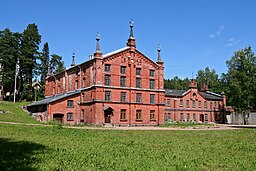Russian Grand Duchy
The history of Finland between 1809 and 1917
The Grand Duchy of Finland (literally Grand Principality of Finland) was the predecessor state of modern Finland. It existed 1809–1917 as part of the Russian Empire and was ruled by the Russian Emperor as Grand Prince. During the Finnish War between Sweden and Russia, the four Estates of occupied Finland were assembled at the Diet of Porvoo on March 29, 1809 to pledge allegiance to Alexander I of Russia who in return guaranteed that the laws and liberties as well as religion would be left unchanged. Following the Swedish defeat in the war and the signing of the Treaty of Fredrikshamn on September 17, 1809, Finland became a true autonomous grand principality, a constitutional monarchy within the autocratic Russian Empire although the usual balance of power between monarch and diet resting on taxation was not in place since the Emperor could rely on the rest of his vast Empire. The title "Grand Prince of Finland" was added to the long list of titles of the Russian Tsar. After his return to Finland in 1812, the Finnish-born Gustaf Mauritz Armfelt became councillor to the Russian emperor. Armfeldt was instrumental in securing the Grand Principality as an entity with relatively greater autonomy within the Russian realm, and for regaining the so-called Old Finland that was lost to Russia in the Treaty of Nystad in 1721.
The history of the Grand Principality can briefly be characterised as:
- 1809–1862: fifty years of consolidation, during which the Finnish authorities succeeded in convincing the Russian court not only of their own loyalty, but of that of all Finns.
- 1863–1898: thirty-five years of increased independence, including the re-establishment of the Diet of Finland and the elevation of Finnish from a language for the common people to a national language equal to Swedish.
- 1899–1917: twenty years of attempted russification, ultimately unsuccessful and detrimental for Finland's relationship with the Russian Empire (and the Soviet Union that was formed shortly afterwards).
The constitutional status of Finland was not codified in Russian law before the February Manifesto of 1899, by which time Finns and Russians had developed quite different ideas about the status of Finland. The autonomy of Finland was at first encouraged by the Russians in part due to the relatively developed governmental structures in Finland (as compared to the emperor-centered Russia of early 19th century) and in part as a deliberate policy of goodwill to win over the minds of the Finnish people. The autonomous status led Finns to develop their own ideas of nationalism and constitutional monarchy, which they could to a large extent implement in practice with the assent of the Tsar. However, while each tsar at the time of his coronation did agree to uphold the special status of the local laws in Finland, there is no evidence that they understood their position as one of a constitutional monarch, despite the growing prevalence of such an interpretation in Finland in the latter part of the 19th century. As governmental organizations developed in Russia, and unity of the empire became one of the leading tenets of Russian politics, clashes between the Russian and Finnish governmental organizations grew frequent and led to the attempted russification.
Finland nevertheless enjoyed a high degree of autonomy, until its independence in 1917. In 1917, after the February Revolution in Russia, Finland's government worked towards securing and perhaps even increasing Finland's autonomy in domestic matters. On December 6, 1917, shortly after the October Revolution in Russia, Finland declared its independence. After the Finnish Civil War, which led to a temporary majority of monarchists in the parliament, Prince Frederick Charles of Hesse was elected the new monarch as king instead of grand prince, marking the new status of the nation, but he never reigned, as a republic was proclaimed.
References: Wikipedia

